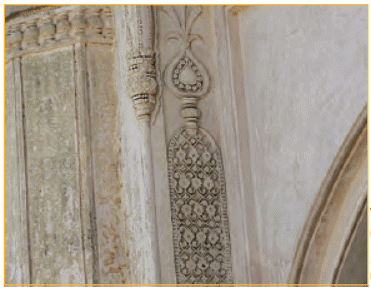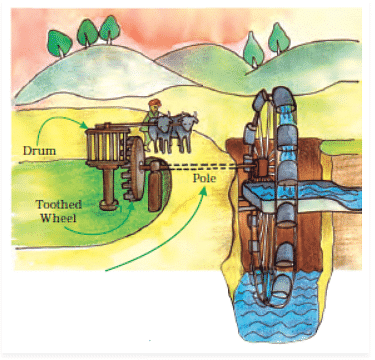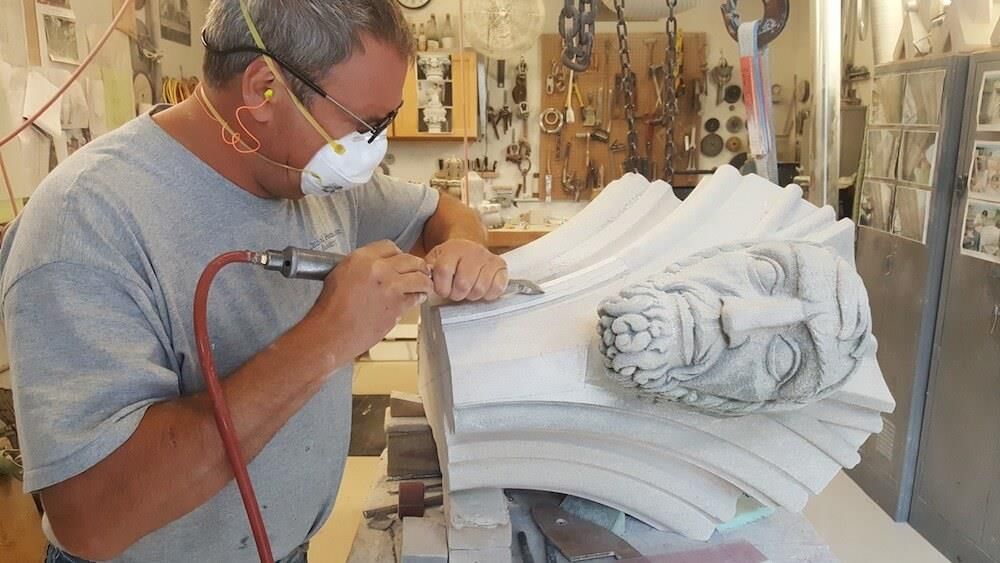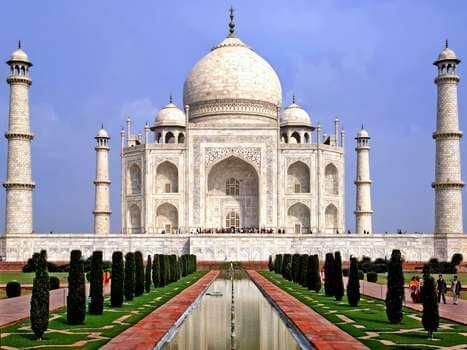NCERT Solutions for Class 5 EVS Chapter 10 - Walls Tell Stories
| Table of contents |

|
| Think |

|
| Think and Discuss |

|
| Where is East-West? |

|
| Tell and Write |

|
| Discuss |

|
| Find Out |

|
| Arrangements of Water |

|
| Close your Eyes and Go back in Time |

|
| Write |

|
| Survey and Write |

|
| What we have learnt |

|
Think
Q1: Why were bastions made in the fort wall?
Ans:
- Bastions were built in the fort wall to give soldiers a higher place to see from.
- This helped them observe the area around the fort and defend it better.
Q2: Why were big holes made in them?
Ans:
- The big holes in the bastions allowed soldiers to peek out and shoot at attackers without fully showing themselves.
- This made the fort stronger in defending against enemies.
 Bastion & Hole
Bastion & Hole
Q3: What difference would be there if you were to look from a straight flat wall or a Bastion at a height? How would the soldiers find peeping from the holes in the bastions useful while attacking?
Ans:
Looking from a Flat Wall vs. a Bastion:
Limited View:
- Flat Wall: Soldiers can't see much around them.
- Bastion: Soldiers can see more from a higher position.
Better Observation:
- Flat Wall: It's hard to spot enemies coming.
- Bastion: Soldiers can see over things that block their view.
Protection:
- Flat Wall: Soldiers are more open to attacks.
- Bastion: Soldiers can hide behind walls and stay safe while fighting.
Easier Attacks:
- Flat Wall: Soldiers have to stand out to shoot.
- Bastion: Soldiers can shoot through holes without showing themselves fully, which keeps them safer.
Think and Discuss
Q1: How would the fountains have worked?
Ans: Fountains would have worked by using water from large tanks.
Q2: What arrangements would have been made in the building for air and light?
Ans: There would have been large windows, doors, and ventilators for air and light.
Q3: Look carefully at the picture of the beautiful carving on the wall. What kind of tools would have been used for such fine carving?
 Carving on the Wall
Carving on the Wall
Ans: These carvings would have been made using a chisel and hammer which were made up of iron.
Q4: We still do not have any electricity in many places in our country. Even in places that do not have electricity, imagine what would happen if there were no electricity for one week. What are the things that would be difficult to manage without it?
Ans: If there were no electricity for one week, life would become challenging in several ways:
- Lighting: Homes would be dark after sunset, making tasks like cooking and reading difficult.
- Food Preservation: Refrigerators would stop working, leading to food spoilage.
- Cooking: Electric stoves would be unusable, complicating meal preparation.
- Communication: Phones and computers would be inoperable, disrupting communication.
- Transportation: Electric public transport systems would cease to operate, making commuting difficult.
- Water Supply: Access to clean water could become a major issue if pumping systems fail.
- Healthcare Services: Hospitals would struggle without power for essential equipment and medicines.
- Entertainment: TVs and computers would be unusable, limiting leisure activities.
- Work and Education: Many jobs and learning activities would halt, impacting productivity and education.
- Safety and Security: Security systems would fail, making homes and neighborhoods less safe.
In summary, a week without electricity would disrupt daily life, affecting basic needs and overall well-being.
Where is East-West?
Q1: At the place you are, where does the sunrise? Where does it set? Where you are standing, find out what is all there to your east. What all is there to your west? Also find out, what places are to your north and south.
(Disclaimer: This is a sample answer, students are advised to answer this on their own)
Ans. The sun rises in the east and sets in the west. Right now, I am in my classroom, and from here, the main gate of the school is in the east, and the playground is in the west. To the north, there are other classrooms, and to the south, there is the administrative block.
Tell and Write
Q1: Look carefully at the map of Golconda. On the map, arrows show all four directions.
 Golconda Map
Golconda Map
(a) If you are peeping inside from Bodli Darwaja, in which direction from you is Katora Hauz?
Ans: Katora Hauz is in north of Bodli Darwaja.
(b) If someone is entering from Banjara Darwaja, in which direction from her is Katora Hauz?
Ans: In the west direction.
(c) In which direction will you walk from Bala Hissar to reach Moti Mahal?
Ans: If he walks in the east of Bala Hissar, we will reach Moti Mahal.
(d) How many gates can you see on the outer walls of the fort?
Ans: There are nine gates on the outer walls of the fort.
(e) Count how many palaces are there in the fort?
Ans: There are three palaces in the fort.
(f) What arrangements for water can you see inside the fort? For example, wells, tanks, and step wells.
Ans: For water, five baolis and three Hauz have been made. On the map, a 1 cm distance is equal to a distance of 110 meters on the ground.
Q2: On the map, a 1 cm distance is equal to a distance of 110 meters on the ground. Now tell
(a) On the map the distance between Bala Hisar and Fateh Darwaja is 8 cm. On the ground, the distance between the two would be 880 meters.
(b) How far is Makai Darwaja from Fateh Darwaja?
Ans: Distance from Makai Darwaza from Fateh Darwaza = 12 × 110 = 1320 m.
Discuss
Q1: Have you recently read or heard about any country attacking or going to war with another country?Ans: Yes, I heard about the Russia-Ukraine War. It started when Russia invaded Ukraine in February 2022. This war has gotten a lot of attention around the world.
 Russia Ukraine War
Russia Ukraine War
Q2: Find out what was the reason for this war.
Ans:
- The main reason for the war is that Russia wants to control Ukraine because it thinks Ukraine should be part of its influence.
- Russia got upset when Ukraine wanted to join NATO and the European Union.
- When Ukraine refused to stop trying to join NATO, Russia decided to attack.
Q3: What kind of weapons were used in this war?
Ans: Many different weapons were used in this war, such as:
- Missiles: These are powerful weapons that can hit targets from far away.
- Artillery: Big guns that shoot shells over long distances.
- Drones: Flying machines that can take pictures or drop bombs.
- Tanks: Strong vehicles that can drive on rough ground and protect soldiers.
- Small Weapons: Guns and rifles used by soldiers in battles.
Q4: What kind of destruction was caused because of this?
Ans: The war caused a lot of damage, including:
- Loss of Life: Many people, including soldiers and civilians, were killed or hurt.
- Destruction of Buildings: Cities like Mariupol and Kharkiv were heavily damaged, with many homes, schools, and hospitals destroyed.
- Displacement of People: Millions of people had to leave their homes to find safety, either in other countries or in different parts of Ukraine.
- Economic Problems: The war has hurt Ukraine’s economy, making it hard for people to work and get food.
Find Out
The big gun that Shreedhar saw was made of bronze. Cannon
Cannon
Q1: Have you seen anything made of bronze? What?
Ans: Yes, I have seen several things made of bronze, such as beautiful idols, shiny medals, old cannons, and decorative items like vases and sculptures. Bronze has a unique look that makes these objects special!
Q2: Find out from your elders about some of the things made from bronze that were, or are still used in your house. From its colour try to identify which one of them is made from copper, which from brass, and which from bronze.
Ans: My elders told me that we have bronze idols and decorative pieces at home.
Here’s how you can identify them by color:
- Copper: This is reddish-brown and is often used for pots and pipes.
- Brass: It has a bright yellow color and is commonly used for door handles and some musical instruments.
- Bronze: It has a shiny grey-black color and is used for things like our idols and some kitchen utensils. This helps us tell which metal is which!
Arrangements of Water
The picture shown here is made after seeing a very old painting of those times.
Q1: Can you think why bullocks have been used here?
Ans: Bullocks are used here because they are strong animals that can help pull heavy loads, like lifting water from a well.
Q2: Use your hand movement to show in which direction in the drum attached to the rod moves when the bullock move?
Ans: When the bullock moves, the drum will turn in an anticlockwise direction.
Q3: In which direction would the ‘toothed wheel’ move?
Ans: The toothed wheel will move in a clockwise direction as it is connected to the drum.
Q4: Now imagine, how would this garland of pots lift water from the well.
Ans:
- The bullocks pull the drum, which then turns the toothed wheel.
- The toothed wheel is connected to the garland of pots by a rod.
- So, when the toothed wheel turns, it makes the garland of pots spin, allowing the pots to scoop up water from the well.
Q5: Do you now get some idea about how the tanks could have been filled by lifting water from the wells?
Ans: Yes, I understand now! The tanks can be filled by lifting water from the wells using this clever system of wheels and pots.
Q6: Where else have you seen such wheels attached to each other? For example, in the gear of a cycle or somewhere else?
Ans: I have seen similar attached wheels in bicycles, old-fashioned mechanical watches, clocks, sewing machines, and big machines used in factories.
 Working of Gear of Cycle
Working of Gear of Cycle
Q7: Look around and find out how water is pumped up from the ground to higher places.
Ans:
- Nowadays, water is pumped up using boring machines and windmills.
- In some villages, they still use traditional methods like bullocks to help lift water.
Q8: How is water pumped up using electricity? How is water lifted without electricity?
Ans:
- Electric machines pump water by drawing it from underground through a tube well and pushing it up to higher places.
- Without electricity, people can lift water using buckets and ropes, windmills, or even with the help of bullocks.
Close your Eyes and Go back in Time
Q1: What is the Sultan doing in the palace? What kind of clothes is he wearing? What dishes are being offered to him? But why does he seem so worried? And in what language is he talking?
Ans:
- Sultan is in a meeting with his ministers.
- He has worn an elegant dress and many jewels.
- Many types of sweet drinks and Mughlai foods are being offered to him.
- But he seems worried due to the invasion of enemies on the fort. He is talking in Persian.
Q2: Imagine the rooms in the palace … the beautiful carpets and curtains, the fountains on the terrace .. and the sweet smell of roses and chameli – where is the coming from?
Ans:
- The palace is looking grand.
- The rooms are decorated with beautiful carpets and curtains.
- Fountains are running on the terrace.
- The sweet smell of roses and chameli is coming from the garden.
Q3: What are the different kinds of factories you can see? How many people are working there? What are they doing? What are they wearing? How long do you think they work?
Ans:
- I can see the factories of clothes, utensils, idols, decorative goods, and arms.
- On average 20 people and working there.
- They are preparing the goods and have worn tight clothes.
- I think they would work early morning to late in the evenings.
Q4: Look there! See finely those craftsmen are carving the stones using a chisel and hammer? Can you see the stone dust in the air? Do you think this stone dust would harm them in the same way?
 Craftsman
Craftsman
Ans:
- Yes, the craftsmen carving the stones with chisels and hammers create a lot of stone dust in the air.
- This dust can be harmful to them, just like other kinds of dust.
- Breathing in too much stone dust can cause health problems, such as lung issues or respiratory problems.
- That's why it's important for craftsmen to wear masks or work in well-ventilated areas to protect themselves from the dust.
Write
Q1: What kind of pots have seen around you?
Ans:
- I have seen many different types of pots around me.
- Some are made of steel, iron, brass, glass, aluminum, and plastic.
- Each type of pot has its own use, like cooking or storing food.
Q2: Try to find out from your grandparents about the other kinds of pots and pans they used in their time?
Ans:
- My grandparents told me that in their time, they used pots and pans made of brass, clay, iron, and copper.
- They said these materials were common for cooking and storing food back then.
Q3: Have you ever been to a museum or heard about it? What all the things are there in a museum?
Ans:
- Yes, I visited a museum once.
- In the museum, there are many interesting things like old artifacts, paintings, and historical items.
- Museums showcase things that help us learn about history and different cultures.
Survey and Write
Q1: Is there any old building or monument near the house which people come to see? If yes, name it.
Ans: Yes, there is a beautiful tomb located near my house. Its name is Darya Khan's Tomb. Many visitors come to admire its architecture and learn about its history.
Q2: Have you ever gone to see an old monument? Which was that? Did you feel it told you a story? What could you know about these times from it?
Ans: Yes, I once visited the Taj Mahal in Agra. It felt like the monument was sharing stories from its past. From it, I learned about the rich culture, exquisite art, and detailed sculptures of the Mughal era.
 Taj MahalQ3: How old was it? How did you know?
Taj MahalQ3: How old was it? How did you know?
Ans: The Taj Mahal is approximately 350 years old. I learned this from my history books, and it is also mentioned on an inscription at the site.
Q4: What was it made of?
Ans: The Taj Mahal is made of stunning white marble, which gives it a beautiful and elegant appearance.
Q5: What color was it?
Ans: The Taj Mahal is primarily white, and it can appear to change colors depending on the time of day and the light.
Q6: Who used to live there in the olden days?
Ans: No one lived in the Taj Mahal, as it is a mausoleum rather than a residence.
Q7: What kinds of activities took place there?
Ans: The Taj Mahal serves as a tomb, housing the graves of the Mughal emperor Shah Jahan and his beloved wife, Mumtaz Mahal. It was a place of remembrance and mourning.
Q8: Do some people still live there?
Ans: No, since the Taj Mahal is one of the Seven Wonders of the World, it is preserved as a historical site, and no one is allowed to live there.
What we have learnt
Q1: Sangeeta thinks it is useless to keep old things in a museum. How would you convince her that it is important to have a museum?
Ans:
- The antiques displayed in a museum provide valuable insights into our culture and heritage.
- They help us learn about various aspects of history, including art, literature, science, and technology.
- Therefore, museums play a crucial role in educating us and preserving our history.
Q2. Why do you think the chapter is named, “Walls Tell Stories?
Ans:
- It is because every historical structure is a witness of their art, culture science, and technology and thus appears to tell the stories of that time.
|
34 videos|240 docs|41 tests
|
FAQs on NCERT Solutions for Class 5 EVS Chapter 10 - Walls Tell Stories
| 1. What is the main theme of the article "Walls Tell Stories"? |  |
| 2. How do walls reflect the culture of a place? |  |
| 3. Can you give examples of how water arrangements are significant in our lives? |  |
| 4. How does going back in time help us understand the present? |  |
| 5. What activities can help students engage with the topics discussed in the article? |  |

|
Explore Courses for Class 5 exam
|

|


















